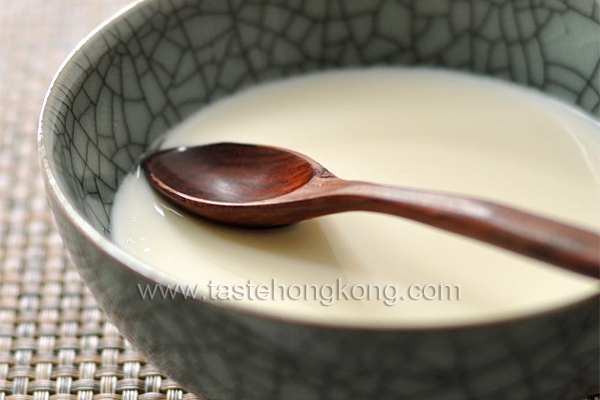
We will not bake or steam. Nor do we need one single curding agent like egg, gelatin, flour, or agar-agar… to make this custard-like dessert. Said to have originated in Southern China along the Pearl River Delta, this is called Ginger Hits Milk 薑撞奶 in our place. A funny name though, it truly describes how the pudding is prepared simply with a natural coagulant.
Heat milk, grate ginger to extract juice, and then pour the first into the second, wait a couple of minutes, then you will get this feathery smooth pudding done. Sounds simple? I have a feeling that this is a recipe that ‘the devil is in the details’. But please don’t be discouraged, they are however manageable details, to be honest.
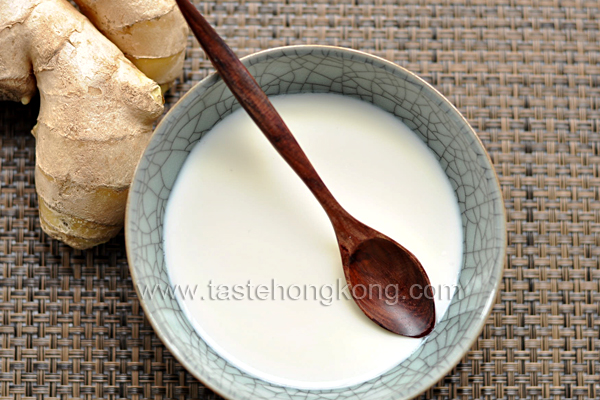
Heat the milk to the right temperature
The milk should be heated to the temperature somewhere between 75 to 80 degree C for curding with the ginger juice. One way to get to that optimum point is to heat up the milk until it starts to smoke, and then swirl it with a spoon for 20 times. I believe this was a wise endeavor when modern tools did not exist. Now, unless your kitchen thermometer has cheated you or there is a limitation, let’s go for this more reliable alternative.
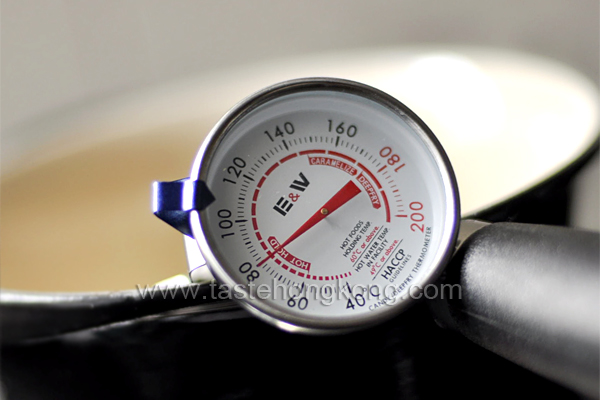
Pick the right ginger
Do not get baby gingers or young gingers because it is the juice from mature or old gingers containing a starchy content that is good for curding the milk. When you crash an old ginger, you shall see beards inside its flesh.
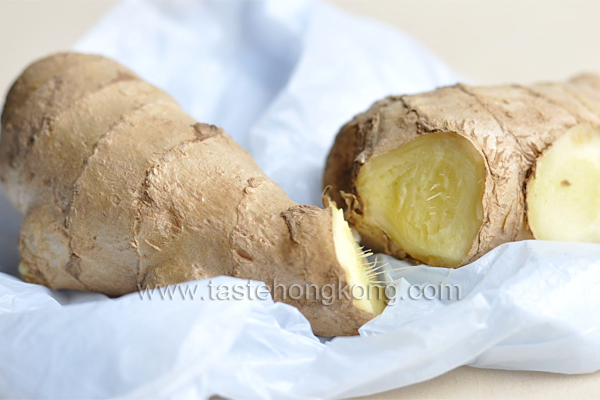
Stir well the ginger juice before hitting the milk
If the ginger juice is rest for a while, the starchy material just mentioned will settle to the bottom. That is why we need to stir the ginger juice before pouring in the milk.
Besides, it is better to pour the milk about 10 cm above the ginger juice. Perhaps doing such is to help mix well the two ingredients because you should NOT stir them after ‘milk hits ginger’.
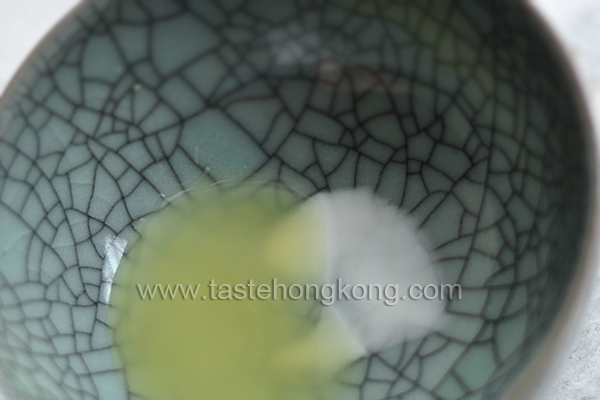
- Ingredients
- 250ml fresh milk
- 2 tsp sugar, or to taste
- 4 tsp fresh ginger juice
- yields two bowls of milk custard
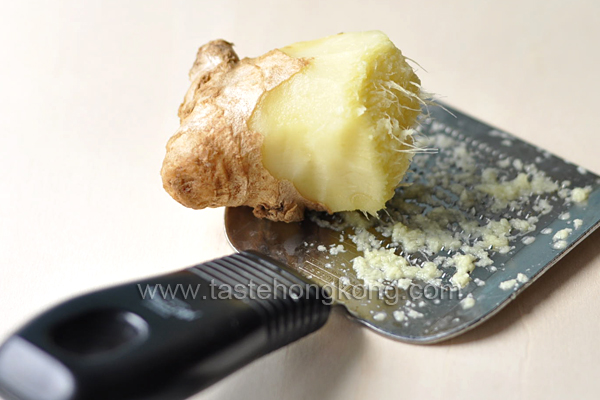
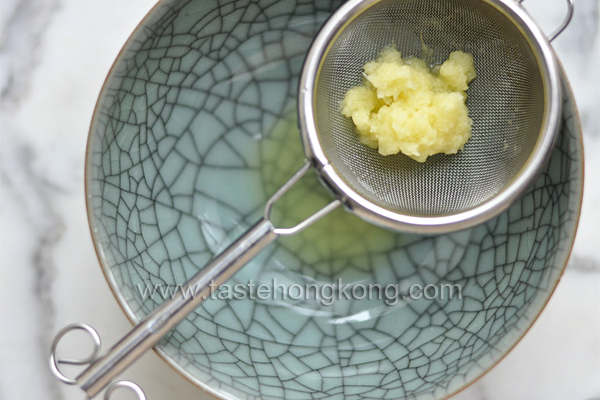
Method
Wash, peel ginger. I leave some skin on one end to avoid slipping while holding it
Grate ginger and juice it by pressing it through a fine strainer until you collect 2 tea spoon of ginger juice. For the remaining end which is too small to be grated further, I would keep it, usually for stir-frying vegetables.
Stir well the ginger juice and divide it into two bowls.
Heat milk with sugar over the lowest flame in pan. Swirl to dissolve sugar. As you feel heat from the milk (or any time earlier if you find it easier), place your kitchen thermometer into the milk. As the temperature reaches 80 degree C, remove from heat.
Right before the milk is removed from heat, give the ginger juice a good stir. Then immediately pour milk from about 10cm above to fill no more than 70% of the bowl, or the milk will easily spill out. So you may need a larger bowl; if doubt, try rehearse the action with water first.
After the milk is added to the ginger juice, DO NOT move or even shake the bowl. Wait for 5 minutes, and the milk ginger mixture will be curdled. Serve immediately.
Enjoy!
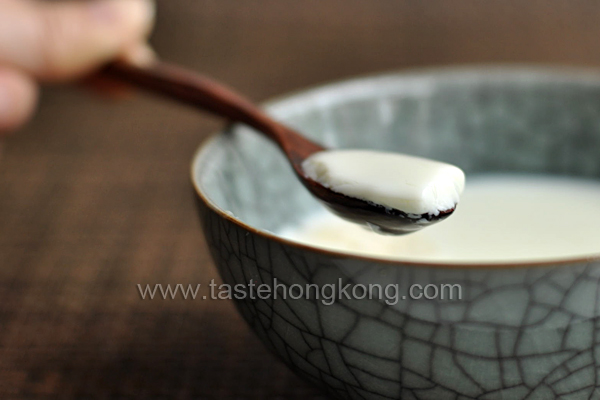
Note:
Be very careful, as the milk is heated, the thermometer gets very hot as well.
You may not want some dusts or dirts land on the pudding in that 5 minutes, so cover the bowl with a plate. It would not affect the curding process.
It has been said that all types of fresh milk can be used for this recipe, but I could only testify the two that I have tried, that is, the pure fresh milk and the high calcium low fat type. Have you got a different experience?
An update on June 24, 2011: Lena, my blogger friend at Frozen Wings, has also made her smooth milk custard too. She shared a great tip in her post on how to pour the milk at the right temperature with no hurries, ” … boiled the milk till it reaches 90C, remove from heat and let it cool down to 80C before pouring into the bowl”. Do visit Lena’s post to see her make no surrenders but overcome the problems.
- Category: Featured . Herb and Spice .
- 69 comments
To get immediate updates and new recipes from my blog, you may also SUBSCRIBE them via RSS feeds. See you there.
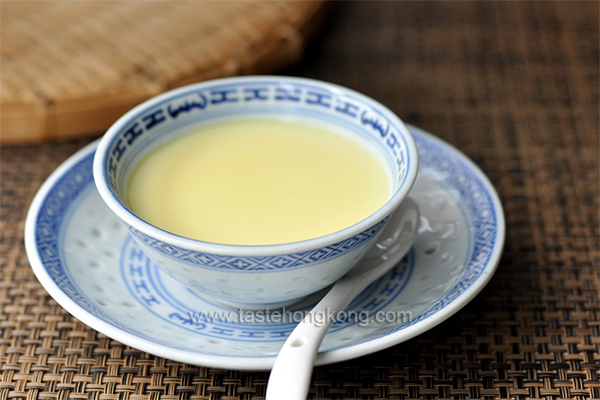
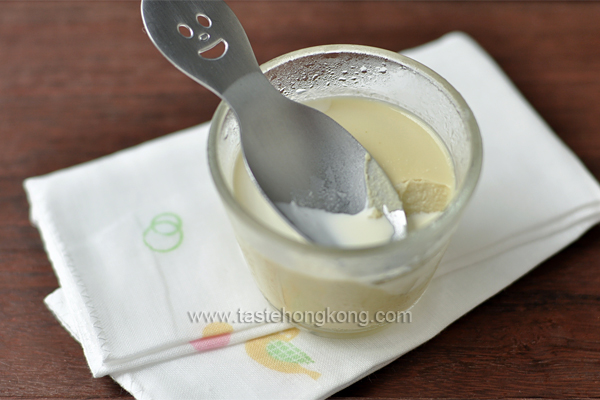
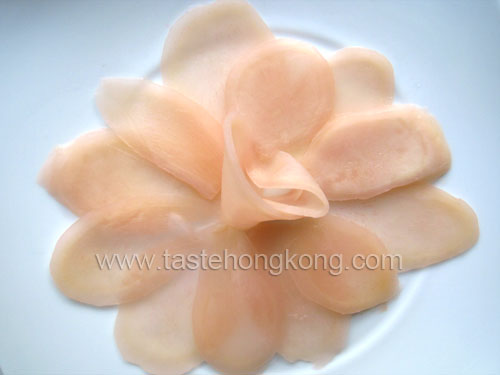
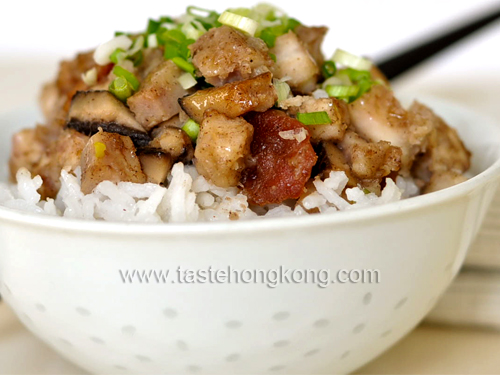
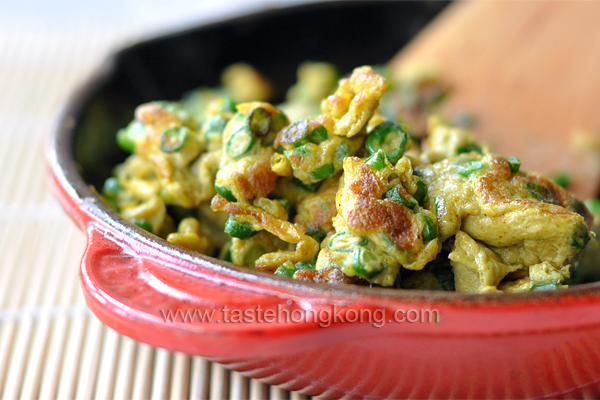
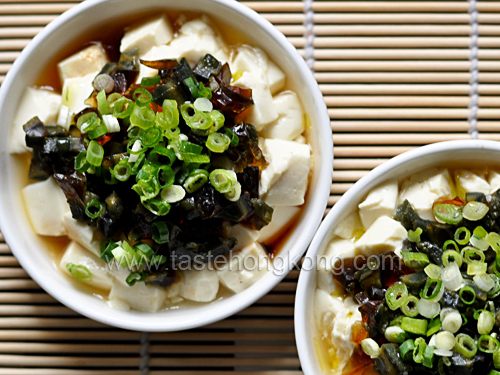
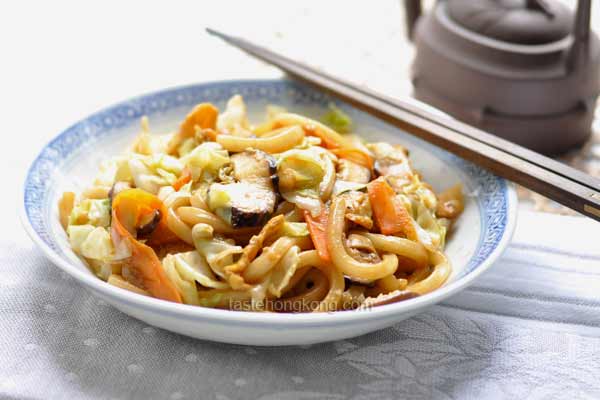
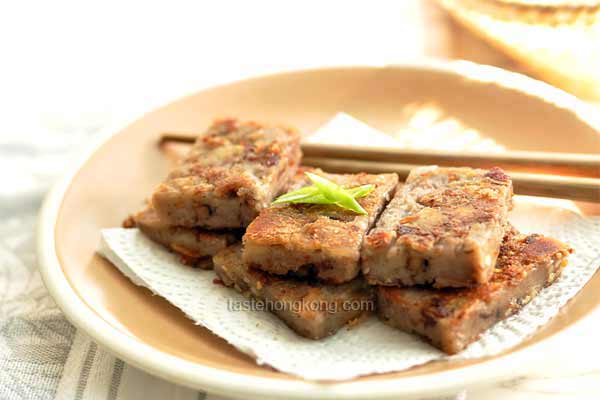
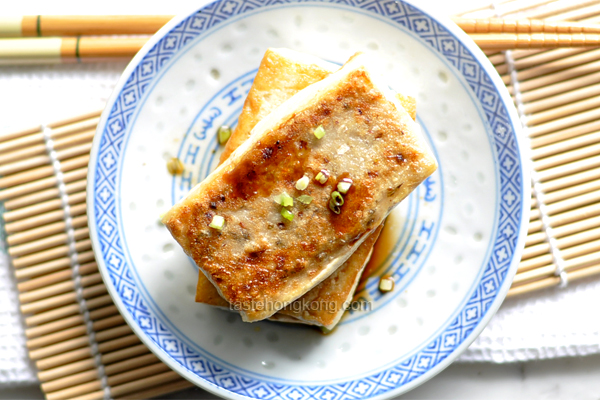
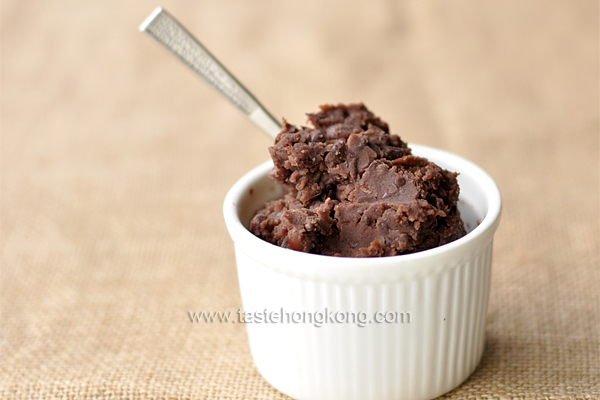



hi, this is somthing that i probably love to eat and am suprised to see that no other coagulants need to put added in to set the pudding. Great!
Thank you for the details. I recalled when I made this the other time, I was not as detailed as you. I always thought need egg or egg whites for curding. I am one who enjoys fresh whole milk! no low-fat milk for me – taste like water ! :O
Thanks for the useful tips.
Thanks for the detail instructions. I will definitely make this!
@Grace,
Great! Enjoy!
yours look incredibly smooth and perfect. I like this dessert and eat this everyday when I holiday in HK. I didn’t know it’s possible to make this without steaming 🙂
@noobcook,
I bet you could make this too.
You must love this pudding very much. There is another dessert that looks and tastes similar to this but is prepared by steaming milk and egg together. Guess you might like it as well.
Probably more dessert houses here serve the steamed milk with egg cause it is easier to be produced in larger batch.
Love this traditional dessert. Our ancestors had the wisdom to make such a good, tasty treat. The modern tools really help us to make things easier.
You did an absolutely perfect job in creating this classic dessert! Thank you!
This is one of my favourite Chinese desserts! What great thinking since years ago 🙂
This is good for our coming winter months ahead… Keeping tummy warm :).. Love it and thank you 😀
I always find this technique amazing!
oh wow! bookmarked. also need tips on almond pudding?
[…] Ginger Milk Pudding, a Natural Custard | Blog about Recipes … […]
I love ginger based desserts and drinks. This one seemed like my cup of tea even though I have never tasted ginger milk pudding.
what a great way to make pudding!! I am wondering if this would work with non-dairy milk such as coconut or almond.
@veggie wedgie,
I’m afraid I do not know the answer; but have intended to try to make soy bean custard with this.
This looks amazing! I’ve tried this before, but haven’t been able to make it smooth (or get the right amount of sugar to ginger ratio). Will try your method. Fingers crossed!
@JJ,
Believe me, I didn’t get it right the first time I made this. Probably I had the thermometer rested too close to the edge of the pan thus recorded a wrong temperature.
But seeing it curded is exciting. Hope you enjoy making this pudding no less than me.
this looks delicious haven’t had like this
Wow, I never had anything like this…and it sure look very tasty. I didn’t know that elements in ginger would curd the milk…will have to try this soon since I have the ingredients handy.
I am amazed. I had no idea ginger had these properties. Not only does the process sound simple (keeping the details in mind), but the flavors sound delicious as well. I must try this!
This is such an interesting dessert! Need to give it a go!
Gonna try this recipe today 😀
I tried making this and ended up with warm ginger milk. haha. Still tasty but I intend to continue trying to make this dish. You did a really good job with this recipie. Also, how did you get your hands on pure fresh milk?
@dlee,
Thanks for writing. Hope my reply isn’t too late and reaches you before your next trial.
I suppose you have taken all steps required, so possibly it is the measurement of temperature. My concern is, if a large pan is used, the height of milk in it may be too minimal to trigger the thermometer (some models) to the right temperature, e.g. though milk is already boiled to 90 degree C but the thermometer may still be recorded below 80 degree C. If my guess applies to your case, please try using a smaller saucepan and make sure the milk is in sufficient contact with the thermometer. Hope this helps and, enjoy making this again!
Here, even packaged fresh milk is labeled as pure fresh milk, meaning it is neither skimmed nor flavored. I didn’t milk it myself at farm : )!
asian milk puddings are an absolute favourite of mine. my mother use to make it for me as a snack when I was hungry. You’ve brought back some very lovely memories. The ginger flavour is perfect for this.
Thanks for the recipe, will try this soon and hope it will work cos I’ve had too many failures
@babe_kl,
Good luck and, enjoy!
hi taste HOng kong, thanks for the all the effort in posting detailed instructions! sigh unfortunately mine sort of curdles at the top but underneath is still too runny. im going to keep trying but just out of curiosity did u try many times before u got it to curdle? i just need some encouragement! also did it start curding exactly after 5 mins? l eave mine for like twenty mins hoping it would curd! thx again!
@viv lim,
If it curdled at the top, I suspect that the milk was not mixed well with the ginger juice. If my guess is correct, you may try to pour the milk right into the center of the ginger juice so that the two do mix thoroughly during the pouring action. Note that the ginger juice has to be stirred well with the starchy content as above.
I did not do it right the first time due to the temperature of the milk. So do also make sure the milk is somewhere between 75 to 80 degree C WHILE POURING. All these are only my wild guesses cause I have not experienced the situation you described, but I hope they help.
Last but not the least, good luck! Get a piece of ginger which is ‘old’ enough to do the job.
I do not have a thermometer at home but I think when the milk is boiling it will form a thin layer of “skin”. Do you think this could be the same temperature as 75 to 80 degree?
I often boil milk (full cream taste better) for my coffee latte with a dash or nutmeg & cinnamon & sometimes will scoop some vanilla ice cream.
@Jamie,
Thankful to your suggestion. But afraid I couldn’t come up with an advice like yours. Although I love the smell of coffee, I could not drink too much of it. And seldom do I make coffee at home, with or without milk.
What I’m sure is that I appreciate your comment.
Thank you for this recipe. My Hong Kong friends described how to make it but never any details. I see the devil is in the details. It is my favorite night-cap.
@Julie L-R,
Sounds like this helps you fall asleep?! Anyway, enjoy!
HI I tired, but it turns out the watery on the milk, it did not solidfy as much as I wanted, what could went wrong somewhere? Thanks!
@Joy Lee,
Let’s then together revisit the important steps first,
– use old ginger
– check if there is any starchy content from the strained ginger juice
– immediately before pouring in the milk, mix well the ginger juice with the starchy content.
Assuming all these steps are correct (and the thermometer works well), then make sure the milk is at the right temperature WHILE it hits the ginger juice. Problems might occur if there is a delay when pouring the
boiledheated milk into the ginger juice. Lena, who also commented here, has shared in her blog on how she got the milk curded without hurries, ” … boiled the milk till it reaches 90C, remove from heat and let it cool down to 80C before pouring into the bowl”. Her experience is very informative. You may read and click to more details from the 4th paragraph under the ‘Note’ above.Hope this helps and good luck!
wow didn’t know this pudding is so easy. Would love to try out the ancient way because I do not have a thermometer. Cross my fingers, Hope it works!
Hi! I wonder after it have curd up,can i still warm it up if i don’t want to eat it immediatley?
@Tracey Chee,
I’d recommend serving the pudding immediately than cooling and warming it up again. The warm pudding, containing milk, might spoil after rested. Besides, I’m not sure whether or not the pudding will remain smooth if warming it up again as I have not tried doing such before.
Wow! Just tried this and it totally worked!! Amazing!! Thanks so much for the detail instructions! I did it with Skim milk and without a thermometer and it worked (just have to keep a very close eye to the milk)!
@Sonia,
You are welcome, and thanks for sharing your experience.
Just tried it for the first time and it worked beautifully. I had to top mine with honey as it wasn’t sweet enough. The flavours melded beautifully. Has anyone tried adding any other flavour ton the milk? I’d like to try adding a little cream to the milk while heating as well as some orange zest or coffee, would this inhibit the curdling process?
@LDP,
Glad that it worked beautiful for you too, and adore your creativity to adapt to your own taste though honestly I have yet to try them out. Enjoy anyway!
Can bottled ginger juice be used in the place of fresh ginger juice?
@D. Yu,
I’m not sure but better not, as it is hard to tell if the bottled juice is made from the old ginger and is fresh enough.
This reminds me of lemon posset, a delightful recipe where cream and lemon make magic and result in a rich, rich pudding that is simple and wonderful. I so love ginger…….it is my current ‘crack’ so this is a must make! Thank you
i feel like your recipes have soul in it… i am from india, well i never found any recipes as simple as yours!!!!
@soorya,
Thanks! I’m happy to hear that you found this simple. Enjoy!
I made 薑撞奶 tonight, and it was amazing! Thank you SO MUCH for posting this recipe. We will go out for this again, because the homemade version is so good. The texture was like the silkiest 豆腐花 I’ve ever had, and the ginger flavor was so pronounced and satisfying.
@Ana C,
Great! Glad you find this satisfying. This is really a tasty, silky pudding.
I’ve been in a sort of “pudding mood” these times, that’s why I finally gave a try to this dessert that had been intriguing me since quite a long time.
It is a very simple recipe that I find yet hard to master like you ! I had to go through several failures to reach a satisfying result, though I hat understood the technique and had a thermometer. But perhaps is it because I expected a slightly different result : is the milk supposed to be evenly set, or is it fine if there is a more runny part at the bottom ?
Anyway, this dessert is not only fun to make, but also really tasty, so thanks for sharing !
@Helena,
The pudding should be evenly set. Just wonder if the milk was poured all the way into the ginger juice (than through the sides of bowl).
Have fun again and good luck!
[…] For wont of something to watch on TV since there was nothing else of interest, I watched this episode and Nicky was making “ginger panna cotta”. Why he called it “panna cotta” was a mystery, but what he was trying to make was a Cantonese ginger custard. I found this recipe online, but I’ve never made it myself so it is just for info only. Cantonese Ginger Custard 薑汁撞奶 […]
[…] Original recipe from Taste Hong Kong. […]
I tried making this and it curdled up, but the milk ended up bitter even though I added sugar. Although it was a failure but the process of making it was fun and interesting. Haha!!!:)
@Benjamin Foo,
Thanks for sharing your experience! But this is my first time hearing of a bitter taste; sounds like something had lost its quality.
Hope the ingredients will work out for you next time, good luck!
Hi,
Thank you very much for providing this recipe! I just made it and it was a hit with my family. Just out of curiosity, is there a way to thicken the consistency of the custard? I would really appreciate a response! Thank you once again!
@X.T.,
Using water buffalo milk might give you a thicker custard. And it is said that the one from Panyu in Guangdong 廣東番禺, a place near to the origin (Shunde 順德) of this recipe, is the best. Some try to add corn starch to the milk to imitate the consistency, but it is a fake version.
Hi, I love ginger. Is it possible to increase the amount of ginger juice?
This is so cool! I love drinking milk with ginger, so I’m sure I’ll love this. Thank you.
Love from Kenya.
Hi,
I read both your post and the frozen wing post and followed the steps.
It is my first attempt and the custard molded into a soft curd which I can scoop it up with a spoon. The surface is firm where I can put the spoon to rest on top of it. It is a pleasure experience.
Only towards the end of the serving did I noticed a layer of liquid which put the curd into semi-liquid form. Do you have any idea why is this so?
@Chris Lim,
Not sure, excuse me! I guess you would not allow it to cool too long before serving.
I see. Thank you
Hello – could you please clarify the amount of ginger juice needed? The ingredients state 4 teaspoons, but under Methods it says 2 teaspoons. Thank you.
And thank you for posting this recipe – my daughter and I discovered Ginger Milk in Chinatown in San Francisco, and have been trying to recreate it ever since.
@Lavamom,
For each bowl of custard, you need 2 tea spoons ginger juice. The recipe amount here (4 tea spoons) is for making two bowls. If you juice the ginger in one batch, give the juice a good stir before dividing to avoid any starchy content depositing to the bottom.
Enjoy!
Ok, thank you – now I understand. We are having mixed results. Mostly we get a very runny custard. But it is still very tasty!
@Lavamom,
Suspect that the ginger you used contained a relatively low starchy content. If you are ready to take an adventure, try adding a bit more of the ginger juice (but the custard shall taste more spicy).
Enjoy!
[…] sweet and smooth yet has the distinct aroma of ginger without the sharp bite. Here’s a recipe from Taste Hong Kong and another from Kitchen […]